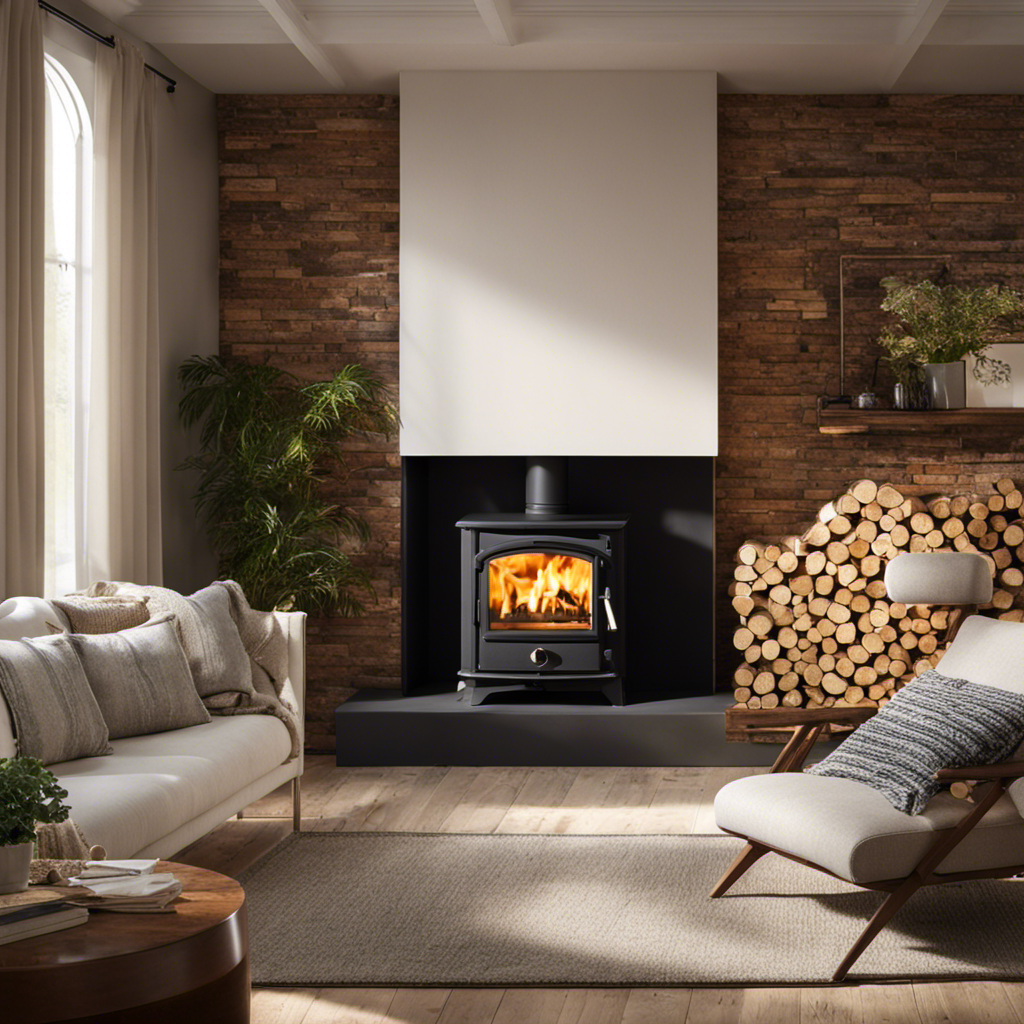Are you tired of the hassle and environmental impact of traditional wood burning? Look no further than wood pellet stoves.
These innovative appliances offer a greener alternative that is both efficient and cost-effective. With wood pellet stoves, you can enjoy the warmth and coziness of a traditional fire, while reducing your carbon footprint.
In this article, we will explore how wood pellet stoves work, their benefits, and tips for choosing and using them safely.
Let’s dive in and discover a more sustainable way to keep warm.
Key Takeaways
- Wood pellet stoves have higher combustion efficiency and lower fuel consumption compared to traditional wood burning stoves.
- Wood pellet stoves reduce carbon emissions, improve air quality, and contribute to a greener future.
- They are a cost-effective heating solution with lower fuel costs and long-term savings.
- Wood pellet stoves utilize renewable energy sources and have a lower carbon footprint compared to electric heaters.
How Wood Pellet Stoves Work
We’ve learned that wood pellet stoves operate by using compressed wood pellets as fuel. These stoves are gaining popularity as a greener alternative to traditional wood burning. One of the major advantages of wood pellet stoves is their efficiency. They’ve a higher combustion efficiency compared to traditional wood stoves, meaning that more of the fuel is converted into heat. This not only reduces the amount of pellets needed but also helps to lower heating costs. Additionally, wood pellet stoves produce fewer emissions and particulate matter compared to traditional wood stoves, making them a cleaner option for heating.
However, there are a few cons to consider. One of the main drawbacks of wood pellet stoves is the need for electricity to operate. Unlike traditional wood stoves, which can be used during power outages, wood pellet stoves require electricity to power the fans and controls. Another consideration is the maintenance required. Wood pellet stoves need regular cleaning to ensure optimal performance and prevent issues such as ash buildup and blockages. To properly clean a wood pellet stove, it’s important to follow the manufacturer’s instructions. This typically involves emptying the ash pan, cleaning the burn pot and heat exchanger, and checking the exhaust system for any obstructions.
Benefits of Wood Pellet Stoves
Wood pellet stoves offer a multitude of benefits that make them an attractive heating option.
They provide environmental advantages by producing lower emissions compared to traditional wood burning stoves.
Additionally, wood pellet stoves are a cost-effective solution for heating homes, offering a sustainable and efficient way to keep warm during the colder months.
Environmental Advantages
Our wood pellet stove reduces carbon emissions and improves air quality.
When compared to electric heaters, wood pellet stoves have several environmental advantages.
First, wood pellets are a renewable energy source, as they’re made from compacted sawdust and other wood waste. This means that using wood pellets for energy helps to reduce our reliance on fossil fuels.
Additionally, wood pellet stoves emit fewer greenhouse gases compared to electric heaters, making them a greener choice.
Wood pellets also have a lower carbon footprint compared to other heating options, as they’re produced from sustainably managed forests.
Cost-Effective Heating Solution
When comparing costs, we find that wood pellet stoves are a more affordable heating option than electric heaters. Not only are they cost-effective, but they also offer several benefits in terms of heating affordability and energy efficiency:
-
Lower fuel costs: Wood pellet stoves use pellets made from compressed wood waste, which are cheaper than electricity. This means that heating your home with a wood pellet stove can save you money on your monthly energy bills.
-
Higher energy efficiency: Wood pellet stoves are designed to be highly efficient, with most models boasting an efficiency rating of over 80%. This means that a significant portion of the heat produced by the stove is effectively transferred to your living space, reducing energy waste.
-
Environmentally friendly: Wood pellets are a renewable energy source, as they’re made from sustainable materials. By choosing a wood pellet stove, you can reduce your carbon footprint and contribute to a greener future.
Comparing Efficiency: Wood Pellet Stoves Vs. Traditional Wood Burning
When comparing the efficiency of wood pellet stoves and traditional wood burning, it’s important to consider various factors.
We’ll examine the environmental impact, cost-effectiveness, and heating efficiency to determine which option is more efficient.
Environmental Impact Comparison
In terms of environmental impact, wood pellet stoves emit significantly less particulate matter compared to traditional wood burning. This makes them a more sustainable heating alternative, with potential for carbon emissions reduction. Here are some key points to consider:
- Wood pellet stoves utilize compressed wood pellets made from waste materials like sawdust or wood chips, reducing the need for new wood harvesting.
- These stoves have higher combustion efficiency, meaning more heat is produced with less fuel, resulting in reduced emissions.
- Pellet stoves also have built-in air controls and advanced combustion technology, minimizing the release of harmful pollutants into the atmosphere.
Cost-Effectiveness Analysis
Considering the cost of installation, maintenance, and fuel consumption, we find that wood pellet stoves can be a more cost-effective option for heating our homes. Not only do they offer cost-saving benefits, but they also contribute to long-term sustainability. Let’s take a closer look at the financial aspects of wood pellet stoves:
| Cost Savings | Traditional Wood Burning | Wood Pellet Stoves | |
|---|---|---|---|
| Installation | Lower cost | Higher cost | Lower cost |
| Maintenance | Minimal | Regular cleaning and maintenance required | Minimal |
| Fuel Consumption | Less fuel needed | More fuel needed | Less fuel needed |
| Longevity | Longer lifespan | Shorter lifespan | Longer lifespan |
As the table shows, wood pellet stoves have lower installation costs and require minimal maintenance. Additionally, they consume less fuel, resulting in long-term cost savings. Moreover, wood pellet stoves have a longer lifespan compared to traditional wood burning options, making them a more sustainable choice for heating our homes. In conclusion, wood pellet stoves offer a cost-effective and environmentally friendly alternative for home heating.
Heating Efficiency Evaluations
After evaluating heating efficiency, we found that the longevity and lower fuel consumption of wood pellet stoves make them a more efficient option for heating our homes.
Wood pellet stoves are a viable alternative to traditional wood burning because they offer several benefits:
-
Energy Efficiency: Wood pellet stoves have a higher heating efficiency compared to traditional wood burning stoves. They can convert a larger percentage of the fuel into heat, resulting in less wasted energy and lower energy bills.
-
Environmentally Friendly: Wood pellet stoves produce fewer emissions and particulate matter compared to traditional wood burning stoves. This makes them a greener option for heating our homes and reduces our carbon footprint.
-
Convenience: Wood pellet stoves are easy to use and require less maintenance compared to traditional wood burning stoves. They can also be automated and controlled remotely, providing convenience and flexibility.
Environmental Impact of Wood Pellet Stoves
Our research indicates that wood pellet stoves have a significantly lower environmental impact compared to traditional wood burning. These stoves offer a sustainable heating method that not only reduces carbon footprint but also provides a solution to environmental concerns.
To better understand the environmental benefits of wood pellet stoves, let’s compare them to traditional wood burning in a table:
| Environmental Impact | Wood Pellet Stoves | Traditional Wood Burning |
|---|---|---|
| Carbon Footprint | Low | High |
| Air Quality | High | Low |
| Renewable Resource | Yes | Yes |
| Waste Management | Efficient | Inefficient |
| Sustainability | High | Low |
As we can see, wood pellet stoves have a lower carbon footprint and contribute to better air quality. This is due to their efficient combustion process, which minimizes emissions. Additionally, wood pellets are made from renewable resources, such as sawdust and wood chips, making them a sustainable heating option.
Wood pellet stoves also excel in waste management. They produce minimal ash and have automated systems for ash removal, ensuring cleaner and more convenient operation. This not only reduces the environmental impact but also enhances the overall user experience.
Cost Savings With Wood Pellet Stoves
When it comes to cost savings, we can see significant benefits with wood pellet stoves. Not only are they an eco-friendly alternative to traditional wood burning, but they also offer financial advantages for homeowners.
Here are some key points to consider:
-
Lower Heating Costs: Wood pellet stoves are known for their efficiency in heating homes. They have a high combustion rate, which means they can produce more heat using less fuel. This can lead to substantial savings on your monthly heating bills.
-
Long-Term Savings: Although the initial installation costs of a wood pellet stove may be higher compared to traditional wood stoves, the long-term savings can outweigh the initial investment. Wood pellets are generally less expensive than other heating fuels, such as oil or propane, and their prices are more stable.
-
Minimal Maintenance Costs: Wood pellet stoves require regular maintenance to ensure optimal performance and longevity. However, the maintenance costs are relatively low compared to other heating systems. Regular cleaning and occasional professional inspections are usually sufficient to keep your wood pellet stove operating efficiently.
Maintenance and Care for Wood Pellet Stoves
In terms of maintenance and care, we find that regular cleaning and occasional professional inspections are essential for optimal performance and longevity of the wood pellet stove. To ensure your wood pellet stove operates efficiently and safely, here are some maintenance tips and a troubleshooting guide.
Firstly, it’s crucial to clean the stove regularly. Remove any ash buildup from the burn pot and clean the glass door to maintain a clear view of the fire. Additionally, clean the exhaust vent and check for any obstructions. This will prevent smoke from backing up into your home and maintain proper airflow.
Another important maintenance tip is to regularly check and clean the air intake. This ensures that the stove receives the necessary oxygen for combustion. A clogged air intake can lead to poor performance and inefficient burning.
If you encounter any issues with your wood pellet stove, here are some troubleshooting steps to follow. If the stove fails to ignite, check if the hopper is adequately filled with pellets and if the power supply is connected. If the stove is producing excessive smoke, ensure that the exhaust vent is clear and that the air intake isn’t blocked.
Choosing the Right Wood Pellet Stove for Your Home
After researching various options, we decided on a wood pellet stove that best suited our home’s heating needs and energy efficiency goals. We considered several wood pellet stove brands and compared their features, performance, and customer reviews. Ultimately, we chose a reputable brand that offered a reliable and efficient heating solution.
When it came to the installation process, we were pleasantly surprised by how straightforward it was. The installation team ensured that the stove was placed in an optimal location, taking into account factors such as ventilation and safety regulations. They also made sure that the stove was properly connected to our existing heating system, allowing for seamless operation.
Here are some key points to consider when choosing and installing a wood pellet stove:
- Research different wood pellet stove brands and compare their features, performance, and customer reviews.
- Consider the heating capacity of the stove to ensure it can adequately heat your space.
- Look for energy-efficient models that will help you save on heating costs.
Overall, choosing the right wood pellet stove for your home and ensuring a proper installation is essential for optimal heating efficiency and comfort. By considering these factors, you can make an informed decision and enjoy the benefits of a greener alternative to traditional wood burning.
Tips for Using Wood Pellet Stoves Safely
Now that we’ve chosen the right wood pellet stove for our home, it’s important to learn how to use it safely. Fire safety is crucial when it comes to using any type of heating appliance, and wood pellet stoves are no exception. By following a few simple tips, we can ensure that our wood pellet stove operates safely and efficiently.
Firstly, it’s important to clean our wood pellet stove regularly. The cleaning procedures may vary depending on the specific model, but generally involve removing ash and soot buildup from the burn pot and the heat exchanger. This not only improves the stove’s efficiency but also reduces the risk of fire.
In addition to regular cleaning, it’s essential to have our wood pellet stove inspected annually by a professional. They can check for any potential issues or safety concerns, such as leaks or faulty components. This will give us peace of mind knowing that our stove is in good working condition.
Furthermore, it’s important to follow the manufacturer’s instructions for operating our wood pellet stove. This includes using the recommended type of wood pellets and following proper ignition procedures. By doing so, we can minimize the risk of accidents and ensure optimal performance.
Frequently Asked Questions
Are Wood Pellet Stoves Suitable for All Types of Homes?
Wood pellet stoves can be suitable for all types of homes. The installation process involves ensuring proper ventilation and a suitable location for the stove.
Regular maintenance is required, such as cleaning the ash pan and chimney, and checking the fuel supply. However, it’s important to consider factors like available space and access to pellets.
Consulting a professional can help determine if a wood pellet stove is the right choice for your home.
How Do Wood Pellet Stoves Compare to Gas or Electric Heating Systems?
How do wood pellet stoves compare to gas or electric heating systems?
Well, let’s weigh the pros and cons.
Wood pellet stoves offer a greener alternative, reducing greenhouse gas emissions and dependence on fossil fuels. They can also be more cost-effective in the long run. However, they require regular maintenance and may not be suitable for all types of homes.
Gas or electric heating systems, on the other hand, provide convenience and reliability.
Ultimately, the choice depends on your specific needs and environmental values.
Can Wood Pellet Stoves Be Used as the Primary Source of Heating in a Home?
Using wood pellet stoves as the primary source of heating in a home has both pros and cons.
On the positive side, wood pellet stoves provide a renewable and greener alternative to traditional wood burning.
They can also save on heating costs compared to gas or electric systems.
However, there are some drawbacks to consider, such as the need for regular maintenance and the cost of purchasing and installing the stove.
It’s important to weigh these factors before making a decision.
Do Wood Pellet Stoves Require a Chimney or Venting System?
Do wood pellet stoves require a chimney or venting system?
Well, when it comes to alternative heating options, like wood pellet stoves, chimney alternatives can be a game-changer. These stoves utilize a forced air system to distribute heat, eliminating the need for a traditional chimney.
Instead, they require a venting system that can be easily installed through an exterior wall. This not only simplifies the installation process but also reduces maintenance requirements, making wood pellet stoves a convenient and eco-friendly choice for heating your home.
Are There Any Government Incentives or Rebates Available for Installing Wood Pellet Stoves?
There are government incentives and energy rebates available for installing wood pellet stoves. These incentives and rebates vary depending on your location and the specific program you’re eligible for.
It’s important to research and contact your local government or energy providers to find out what incentives are available to you. Taking advantage of these incentives can help offset the cost of purchasing and installing a wood pellet stove, making it a more affordable and environmentally friendly option for heating your home.
Conclusion
In conclusion, wood pellet stoves offer a greener and more efficient alternative to traditional wood burning. With their advanced technology, they provide a cleaner burn and reduce harmful emissions.
Not only do they help protect the environment, but they also offer cost savings and require less maintenance.
By choosing the right wood pellet stove for your home and following safety guidelines, you can enjoy the warmth and comfort while contributing to a sustainable future.





